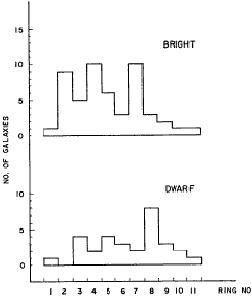


3.2. Luminosity segregation
The idea that clusters form by gravitational clustering of field galaxies led Zwicky [513] (and others) to suggest that cluster galaxies are more massive than average, making their mutual gravitational attraction stronger. The most massive galaxies would cluster first, forming the cluster core, and other galaxies would follow. Assuming proportionality between a galaxy luminosity and its mass, Zwicky then thought that luminosity segregation must exist in clusters. Between 1942 and 1951 he found some evidence for it in Virgo [515], and in Coma [519]. At the same time he noted that also dwarf galaxies are clustered (8), an evidence later confirmed by Reaves [366] and Hodge [220].

|
Figure 10. The radial distribution of bright and dwarf galaxies in the Coma cluster. From Rood & Turnrose (1968). |
In the sixties, Reaves [368] and Rood & Turnrose [388] showed that dwarf galaxies are less clustered than giant galaxies - see Fig. 10. Not much later, Rood [381] and Rood & Abell [384] noted that the bright peak in the luminosity function of Coma galaxies (first described by Shapley [416] in 1934), is not present in the outer regions of the cluster. This was interpreted as evidence for an excess of bright galaxies in the cluster core, i.e. luminosity segregation.
Oemler [331] noted an increase of the mean radius of cluster galaxies with galaxy magnitudes, another evidence for luminosity segregation, which was not seen, however, in spiral-rich clusters.
Capelato et al. [91] examined in detail the luminosity segregation in Coma, showing that it concerns the most luminous galaxies in a range of about 2 magnitudes. They also enlightened the role of the central cD in destroying the evidence of luminosity segregation through cannibalism, as originally suggested by Dressler [140].
Luminosity segregation also had opponents, like Noonan [326], Bahcall [40], and Sarazin [398], who suggested the evidence for luminosity segregation to be spurious, and mostly due to poor background subtraction. Recent analyses [69, 73], based on cluster members only, show that luminosity segregation is indeed limited to the very bright galaxies only, MR < - 22.6.
8 Reaves noted that the main problems for
the identification of dwarf galaxies were their low surface brightness,
and the fact that these galaxies ``resemble water spots and
certain common emulsion defects''.
Back.